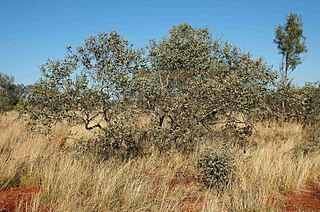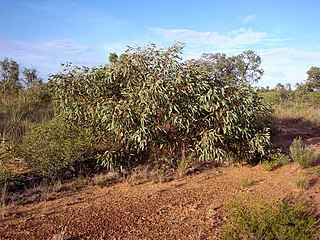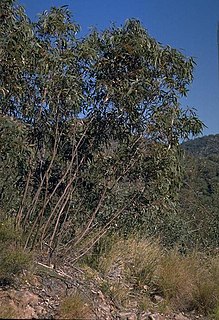
Eucalyptus herbertiana, commonly known as Kalumburu gum or yellow-barked mallee, is a species of small tree or mallee that is endemic to northern Australia. It has smooth bark, lance-shaped or curved adult leaves, flower buds in groups of seven, white flowers and cup-shaped, hemispherical or conical fruit.

Eucalyptus pachyphylla, commonly known as thick-leaved mallee or the red-budded mallee, is a species of mallee that is native to inland Australia. It has smooth bark, egg-shaped to lance-shaped adult leaves, flower buds in groups of three with five prominent ribs on each bud, and broad, shallow, conical to hemispherical fruit.
Corymbia aureola, commonly known as yellowjacket or yellow bloodwood, is a species of tree that is endemic to Queensland. It has rough bark on the trunk and larger branches, lance-shaped to curved adult leaves, flower buds in groups of seven and barrel-shaped, urn-shaped or cylindrical fruit.
Corymbia bunites, commonly known as the Blackdown yellowjacket, is a species of tall tree that is endemic to Queensland. It has rough bark on the trunk and branches, lance-shaped or curved adult leaves, flower buds in groups of seven, white flowers and barrel-shaped, urn-shaped or spherical fruit.
Corymbia leptoloma, commonly known as the yellowjacket or Paluma Range yellowjacket, is a species of tree that is endemic to Queensland. It has rough, tessellated bark on the trunk and branches, lance-shaped or curved adult leaves, flower buds in groups of seven and barrel-shaped, urn-shaped or shortened spherical fruit.
Corymbia petalophylla is a species of tree that is endemic to Queensland. It has rough, tessellated bark on the trunk and branches, lance-shaped or curved adult leaves, flower buds in groups of seven, white flowers and barrel-shaped, urn-shaped or shortened spherical fruit.
Corymbia xanthope, commonly known as Glen Geddes bloodwood, is a species of tree that is endemic to a small area of Queensland. It has thick, rough bark on the trunk and branches with yellow bark visible underneath, lance-shaped to curved adult leaves, flower buds in groups of seven, creamy white flowers and urn-shaped fruit.

Eucalyptus ammophila, commonly known as the sandplain red gum, is a mallee that is endemic to central and southern Queensland. It has rough fibrous bark near the base and smooth greyish and orange to bronze bark higher up. It has lance-shaped leaves, yellow or creamy flower buds in groups of between seven and eleven, white flowers and hemispherical fruit with strongly raised valves.
Eucalyptus corynodes is a species of tree that is endemic to Queensland. It has hard, dark grey "ironbark", lance-shaped to curved adult leaves, flower buds usually on a branching inflorescence, the buds in groups of seven, white flowers and barrel-shaped to cup-shaped fruit.

Eucalyptus crucis is a species of mallee that is endemic to Western Australia. There are three subspecies, commonly known as silver mallee or Southern Cross mallee,, narrow-leaved silver mallee, and Paynes Find mallee,. It has rough bark that is shed in curling flakes, more or less round, glaucous juvenile leaves, egg-shaped intermediate leaves and lance-shaped adult leaves. The type of bark and the proportion of juvenile, intermediate and adult leaves in the crown of mature plants varies with subspecies. The flower buds are arranged in groups of seven in leaf axils, the flowers are whitish to pale yellow and the fruit is a conical to hemispherical capsule.
Eucalyptus decolor is a species of small to medium-sized tree that is endemic to Queensland. It has rough, hard, fissured "ironbark", lance-shaped to curved adult leaves that are distinctly paler on the lower surface, flower buds in groups of seven, white flowers and hemispherical to cup-shaped fruit.
Eucalyptus kabiana, commonly known as Mt Beerwah mallee, is a species of mallee, rarely a small tree, that is endemic to Queensland. It has smooth white to grey bark, sometimes with a short stocking of rough, fibrous bark at the base. The adult leaves are lance-shaped or curved, the flower buds are arranged in groups of between seven and eleven, the flowers are white and the fruit is hemispherical with protruding valves.
Eucalyptus melanoleuca, commonly known as yarraman ironbark or nanango ironbark, is a species of tree that is endemic to south-east Queensland. It has rough ironbark on the trunk and larger branches, smooth bark above, lance-shaped adult leaves, flower buds in groups of seven, white flowers and barrel-shaped, to cup-shaped or conical fruit.
Eucalyptus provecta is a species of small tree that is endemic to Queensland. It has rough, fibrous to flaky bark on the trunk and branches, lance-shaped adult leaves, flower buds in groups of seven on the ends of branchlets, white flowers and cup-shaped fruit.

Eucalyptus pumila, commonly known as the Pokolbin mallee, is a species of mallee that is endemic[ to New South Wales. It has smooth bark, lance-shaped to curved or elliptical adult leaves, flower buds in groups of seven, white flowers and hemispherical or cup-shaped fruit.

Eucalyptus rhombica is a small to medium-sized tree that is endemic to a small area of south-east Queensland. It has rough, ironbark on the trunk and larger branches, smooth bark above, lance-shaped adult leaves, flower buds in groups of seven, white flowers and cup-shaped or conical fruit.
Eucalyptus tardecidens is a species of mallee or small tree that is endemic to north Queensland. It has rough, fibrous or flaky bark on the trunk and branches, lance-shaped adult leaves, flower buds in groups of seven, white flowers and shortened oval to cylindrical fruit.
Eucalyptus terrica is a species of small tree that is endemic to south-eastern Queensland. It has thin, rough, fibrous bark on the trunk and larger branches, smooth bark above, lance-shaped adult leaves, flower buds in groups of seven, white flowers and hemispherical fruit.
Eucalyptus tholiformis is a species of tree that is endemic to a small area in Queensland. It has rough, deeply furrowed iron bark on the trunk and larger branches, lance-shaped adult leaves, flower buds in groups of seven, white flowers and cup-shaped to funnel-shaped fruit.
Eucalyptus nudicaulis is a species of mallee that is endemic to a small area in north-west Queensland. It has smooth, mottled grey bark, narrow lance-shaped adult leaves, flower buds in groups of seven, white flowers and cup-shaped to hemispherical fruit.






